|
Biographies
Source:
History
of Cuyahoga Co., Ohio
Published by D. W. Ensign & Co.,
1879
< BACK TO BIOGRAPHICAL INDEX FOR 1879 >
< BACK TO ALL
BIOGRAPHICAL INDEXES FOR CUYAHOGA COUNTY >
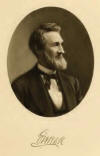
E. B. Hale |
EDWIN B. HALE,
The subject of this sketch, who is one of the most prominent and
successful bankers and business men of the city, belongs to one
of the oldest and best known families in England and the United
States; and, although it would greatly transcend the limits
allowed here to trace its history at length and mention all who
have reflected credit on their ancient and honorable name yet a
brief notice of a few points may not be inappropriate.
In the history and antiquities of the county of Essex,
England, by Philip Mornant, London, 1768, we find
numerous references to the family of Hales. As
early as the thirteenth century the family name appears among
the burgesses in parliament, and is referred to in the history
of the reigns of Richard the First, Edward the Third and
their immediate successors. Many members of the family
were called to offices of trust and position by the communities
in which they lived, and the name is mentioned with honor in
both civil and military annals - Sir Mathew Hale, the
upright judge being one of the most distinguished of the family.
The office of high sheriff of the county was frequently filled
by some one hearing the name of Hale, and the family has
almost continuously had a representative in one or both houses
of parliament.
Members of the family at an early date settled in New
England; the first settler of the name of Connecticut being
Samuel Hale, (son of William Hale, Esq., of Kings
Walden, England, high sheriff of Hertfordshire in 1621, who
married Rose, daughter of Sir George Bond, Knight
Lord Mayor of London, in 1587,) who located in the neighborhood
of Hartford about the year 1640. On the annals of
Glastonbury, Connecticut, (so named from the famous old monastic
town in England, which was distinguished as a seat of learning
and where the first Christian church was erected about the year
600) we find the names of his descendants quite prominent; they
being engaged in various wars of the olden time - notably in
King Philip's war, the old French and Indian war and
the war of the Revolution. In the war of the Revolution no
less than sixteen able bodied men, heads of families, by the
name of Hale, all from this small settlement of
Glastonbury, attached themselves to the army as soldiers and
gave good evidence of their patriotism y risking their lives in
their country's service.
Philo Hale, the father of the subject of this
sketch, was a man of remarkable energy and enterprise, and was
the first who engaged in and established the business of ship
building on the Connecticut river, which he conducted
successfully until the sudden outbreak of the war of 1812.
The war ruined his business and involved him in serious loss.
He afterwards traveled extensively abroad, but, finding no
foreign country like his native land, came back, improved his
broken fortunes and, attracted by the beauty of the prairie
country, gave his means and energies to the development of the
interests of central Illinois, where he died in 1848,
universally esteemed and respected as a public-spirited citizen.
The son of whom we write was born in Brooklyn, Long
Island, Feb. 8, 1819. During his infancy his parents
removed to Connecticut, and gave him in early youth the
advantages of the best schools. The death of his mother,
two brothers and a sister, its an early period of life,
prevented him from entering Yale College, and defeated all the
family plans for his farther education. The young boy then
found himself dependent upon the sympathy of distant relatives.
He came to Ohio, and entered Kenyon College in 1837, where he
gave his entire attention to his studies and graduated with the
honors of his class in 1841, having a personal friend in every
member of the faculty and the kind regard of all his fellow
students. Fond of letters, it was his intention to devote
himself to the pursuts of literature, but after much
discussion, and rather in deference to the wish of his father,
he turned his attention to the legal profession and entered the
office of Goddard & Converse, attorneys at Zanesville,
Ohio, and was admitted to the bar, after an examination
conducted by the Hon. Joseph Root, in 1843. After
this, business required his presence in Illinois, and absorbed
his attention for several years.
In 1852, after the death of his father, he removed to
Cleveland, attracted thither by its beautiful situation, its
climate, the enterprise of its citizens, and its educational and
other advantages. He there commenced business as a private
banker and is still so engaged. Mr. Hale is a
strictly conscientious and conservative man, cautious and
considerate, thoughtful and well balanced. In his business
relations he is highly respected, and his counsel is freely and
frequently sought. In his immediate social circle genial
and pleasant, he is cherished and beloved. As a citizen he
is quiet and unostentatious, but always interested in every
measure for the public good, and the poor have ever found in hi
a true and sympathetic friend.
In 1846 he was married to the daughter of S. N.
Hoyt, Esq., of Chardon, Ohio, and now has three sons and
four daughters living, some of whom are married and reside in
the immediate neighborhood of their father's residence.
Source: History of Cuyahoga Co., Ohio -
Published by D. W. Ensign & Co., - 1879 - Page 354
Portrait Source: History of Cuyahoga Co., Ohio - Published by D.
W. Ensign & Co., - 1879 - Page 298a |
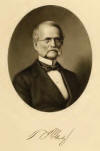
T. Pl. Handy |
TRUMAN P. HANDY
was born in Paris, Oneida county, New York, on the 17th day of
January, 1807. He received a good education at an academy
and made preparations for entering college, but at the age of
eighteen he accepted a clerkship in the Bank of Geneva, in
Ontario county in that State. Five years later he resigned
and removed to Buffalo, to assist in the organization of the
Bank of Buffalo, in which he held the position of teller for one
year.
In 1832 he removed to Cleveland, having been invited
there for the purpose of resuscitating the Commercial Bank of
Lake Erie, established in 1816, the charter of which had been
purchased by Hon. George Bancroft, of Massachusetts.
Mr. Handy accepted the post of cashier and reorganized
the bank, which prospered until 1842, when its charter expired
and a renewal was refused by the legislature. In the
financial crash of 1837 it had been compelled to accept real
estate in settlement of the estate of its involved customers,
and thus became one of the largest landholders in the city.
When its business was closed Mr. Handy was appointed
trustee to divide this property among the stockholders.
This task he completed in 1845.
Meanwhile he had, in 1843, established a private
banking house under the firm name of T. P. Handy & Co.,
in conducting the business of which he met with his accustomed
success. In 1845 Mr. Handy organized the Commercial
Branch Bank, under the act of legislature of that year
authorizing the establishment of the State Bank of Ohio.
He assumed the cashiership and was also the acting manager.
The success of his management of its affairs may be inferred
from the fact that the stockholders realized an average of
twenty per cent, on their investments for a period of
twenty-years, until the termination of the charter in 1865.
In 1861 Mr. Handy was called upon to revive the
credit of another important institution, which had been
seriously crippled by the failure of the Ohio Life and Trust
Company. He accepted the presidency of the establishment
in question (the Merchants' Branch of the State Bank of Ohio),
and under his management it rapidly recovered its lost ground.
In February, 1865, it was reorganized as the Merchant's National
Bank under the United States banking law, with a capital of one
million dollars, six hundred thousand of which were paid in.
Mr. Handy was elected president of the reorganized
institution, and conducted its affairs with great success.
From 1850 to 1860 he also served as treasurer of the
Cleveland, Columbus and Cincinnati railroad company, and managed
its finances with sagacity and skill. This position he
resigned in 1860, but has ever since been a director of the
company.
Mr. Handy was also among the first to
demonstrate the practicability of establishing a profitable
commerce with Europe, direct from the lake ports. In 1858
he despatched three of a fleet of ten merchant vessels, mostly
laden with lumber and staves, which left Cleveland for English
ports, and since that time there has been ore or less direct
trade maintained between Europe and the ports of the American
lakes.
Mr. Handy never sought nor held positions of
political prominence. Few, however, have taken so deep an
interest in educational and philanthropic causes, or labored so
earnestly for their success. He served as a member of the
board of education with Charles Bradburn, and was one of
that gentleman's ablest coadjutors in the arduous task of
reorganizing and improving the school system of Cleveland.
In the Sunday-schools he was for more than forty years a
constant worker both as superintendent and teacher, taking an
active part in all measures calculated to extend their field of
usefulness. For twenty-one years he was president of the
Industrial Home and Children's Aid Society, of which he has ever
been one of the most liberal supporters.
A life-long and sincere member of the Presbyterian
church, he is singularly free from "isms" of any description,
and at all times advocated their exclusion from oral or
political theories or questions. He is broad and liberal
in his views, generous and just in his acts, universally
esteemed and particularly beloved by children. He is one
of the few citizens to be found in any community whose effective
labors for the relief of the poor and helpless, and the rescue
of the ignorant and vicious, justly entitled them to the name of
philanthropists. He made three extended visits to Europe,
chiefly for the purpose of investigating the financial,
religious and educational systems of the old world, and
Cleveland was equally benefitted with himself by the valuable
knowledge he there gained.
In March, 1832, Mr. Handy was married to Miss
Harriet N. Hall of Geneva, New York, by whom he has one
daughter, who married Hon. John S. Newberry, of Detroit,
Michigan.
Source: History of Cuyahoga Co., Ohio -
Published by D. W. Ensign & Co., - 1879 - Page 355
Portrait Source: History of Cuyahoga Co., Ohio - Published by D.
W. Ensign & Co., - 1879 - Page 296a |
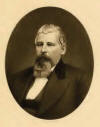 |
S. V. HARKNESS
Portrait Source: History of Cuyahoga Co.,
Ohio - Published by D. W. Ensign & Co., - 1879 - Page 400a
(Note: This one has no name on it but according to the
list of Illustrations, it is S. V. Harkness) |
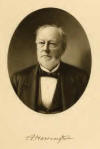 |
BENJAMIN HARRINGTON
Source: History of Cuyahoga Co., Ohio -
Published by D. W. Ensign & Co., - 1879 - Page 356
Portrait Source: History of Cuyahoga Co., Ohio - Published by D.
W. Ensign & Co., - 1879 - Page 240a |
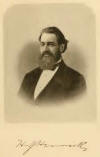
H. J. Herrick |
HENRY J. HERRICK
Source: History of Cuyahoga Co., Ohio -
Published by D. W. Ensign & Co., - 1879 - Page 357 |
| |
RENSSELAER R. HERRICK
Source: History of Cuyahoga
Co., Ohio - Published by D. W. Ensign & Co., - 1879 - Page
357
Portrait Source: History of Cuyahoga Co., Ohio - Published by
D. W. Ensign & Co., - 1879 - Page 356a |
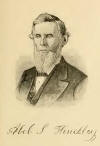
Abel S. Hinckley |
ABLE S. HINCKLEY
Source:
History of Cuyahoga Co., Ohio - Published by D. W. Ensign & Co.,
- 1879 - Page 424 |
| |
ORLANDO J. HODGE
Source: History of Cuyahoga Co., Ohio
- Published by D. W. Ensign & Co., - 1879 - Page 359 |
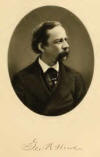
Geo. W. Howe |
GEORGE WILLIAM HOWE
Source: History of Cuyahoga Co., Ohio -
Published by D. W. Ensign & Co., - 1879 - Page 360 |
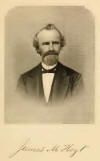
James M. Hoyt |
JAMES M. HOYT
Source: History of Cuyahoga Co., Ohio -
Published by D. W. Ensign & Co., - 1879 - Page
361
Portrait Source: History of Cuyahoga Co., Ohio - Published by
D. W. Ensign & Co., - 1879 - Page 320a |
 |
HINMAN B. HURLBUT.
This gentleman was born in St. Lawrence county, New York, on the
29th day of July, 1818 and is descended from the best of New
England blood. His ancestors resided for several
generations in the State of Connecticut, where his father
followed the occupation of a farmer before removing to New York.
His grandfather was a captain in the Revolutionary army, taking
a part in the memorable battle of Long Island and other
engagements. Through his mother Mr. Hurlbut is
descended from Gov. Hinman, one of the colonial rulers of
Connecticut
At eighteen years of age the subject of this sketch,
after enjoying such educational advantages as his vicinity
afforded, removed to Cleveland and entered the law office of his
brother (H. A. Hurlbut, Esq.,) as a student. After
being admitted to the bar in 1839, he at once opened an office
in Massillon, Ohio, and in a short time secured a remunerative
practice. In 1846 he formed a partnership with the Hon.
D. K. Cartter, afterwards chief justice of the District of
Columbia, their practice being very extensive and lucrative.
In 1852 Mr. Hurlbut retired from his profession,
having already become engaged in the banking business as the
senior member of the firm of Hurlbut and Vinton of
Merchants" and "The Union," and was a member of the State board
of control.
In 1852 he removed to Cleveland and established still
another banking house there, under the firm name of Hurlbut
& Co., retaining, however, his interests at Massillon. He
next purchased the charter of the Bank of Commerce and
reorganized it, with himself as cashier and T. P. Handy
as president. Mr. Handy resigned the following
year, when Mr. Joseph Perkins was chosen president.
After the passage of the national banking law by Congress,
Mr. Hurlbut again reorganized this institution as the Second
National Bank of Cleveland.
In 1856 the subject of this sketch, in company with
Amasa Stone, Stillman Witt, Joseph Perkins and James
Mason, of Cleveland, Henry B. Perkins, of Warren and
M. R. Waite, (now Chief Justice of the United States) and
Samuel Young, of Toledo, purchased the charter of the
Toledo Branch of the State Bank, which they reorganized as a
national bank in 1866. This bank, under Mr. Hurlbut's
management was probably one of the most successful monetary
institutions ever established.
In 1865 Mr. Hurlbut was obliged to give up his
numerous business enterprises on account of the loss of his
health, and he concluded to seek rest and recreation in an
extended European tour. He returned to America in 1868,
but remained in retirement until 1871, when he was elected vice
president of the Cleveland, Columbus, Cincinnati and
Indianapolis railroad company, since which time he has been
largely interested in many of the railroad enterprises of the
Western States. He is now president of the Indianapolis
and St. Louis and the Cincinnati and Springfield railroads, and
is also vice president of the Cleveland, Columbus, Cincinnati
and Indianapolis railroad.
While so largely interested in financial and commercial
enterprises, Mr. Hurlbut has found time for the
gratification of the refined taste, and his large means,
acquired by business ability and application, have been
liberally bestowed on educational and benevolent enterprises,
and in aid of the arts and sciences as well as other kindred
objects. He gave largely to the City Hospital, of which he
was the founder, and he is now the president of the society and
its chief supporter. It is safe to say that there is
hardly a charitable institution in Cleveland or its vicinity to
which he has not liberally contributed.
Mr. Hurlbut also established the Hurlbut
professorship of the natural sciences at Western Reserve
College, at Hudson, and endowed it with twenty-five thousand
dollars.
He was probably collected the finest gallery of
painting ever brought together in Ohio, if not in the whole
West, in which are represented such artists as F. E. Church,
Alex. Cabenel, Baugerean, H. Merle, L. Knauss, Bauguiet,
Kaulbach, S. R. Gifford, Verboeckhoven, Beyschlegg, Meyer Von
Brunn, Bricher, Felix Zerms, T. W. Wood, Jarvis McEntee, and
others only less renowned.
In early life a member of the Whig party, he took an active
part in politics, and was a member of the convention which
nominated General Taylor for President, and ably
supported him during the succeeding campaign, making a large
number of speeches in his own district. During the war for
the Union Mr. Hurlbut was a staunch supporter of the
government, and gave freely to various benevolent enterprises
called into existence by that struggle.
In May, 1840, Mr. Hurlbut was married to Miss
Jane Elizabeth Johnson, of Oneida county, New York.
Mr. Hurlbut's life and business success have
been but another example of what may be expected from the sons
of New England - descended as they are from the best old English
stock, inspired with new life by the stirring scenes of the
Western world. Many of them are still going farther on, as
did their ancestors of old, to build up a new country in the
distant West, and although they often have naught to begin with
save their own strong arms, stout hearts and clear brains, yet
again and again is Fortune seen to crown their efforts with her
richest gifts.
Source: History of Cuyahoga Co., Ohio -
Published by D. W. Ensign & Co., - 1879 - Page
362
Portrait Source: History of Cuyahoga Co., Ohio - Published by
D. W. Ensign & Co., - 1879 - Page 256a |
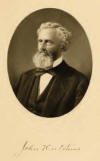
John Hutchins |
JOHN HUTCHINS
was born in Vienna, Trumbull county, Ohio, July 25, 1812.
His father, Samuel Hutchins, and his mother, whose maiden
name was Flower, were natives of Connecticut, and among
the earliest settlers in the Western Reserve. Samuel
Hutchins first came to Ohio in the year 1798, and in 1800
drove an ox-team from Connecticut to Vienna, where he then
settled. He had a family of three sons and four daughters,
the subject of this notice being the fourth child. He was
educated in the common schools of the county until about twenty
years of age, when he pursued his studies with a private tutor,
and subsequently entered the preparatory department of Western
Reserve College. He commenced the study of law at Warren,
Ohio, in 1835, in the office of David Tod, afterwards
well known as one of Ohio's ablest war governors, and was
admitted to the bar in the fall of 1838, at New Lisbon.
After about one year's practice of his profession he
was appointed clerk of the court of common pleas of Trumbull
county, in which capacity he served five years. He then
resigned and entered the law firm of Tod & Hoffman, which
became Tod, Hoffman & Hutchins. He afterward became
connected with J. D. Cox, since Governor Cox, and
was his partner at the breaking out of the rebellion. In
1868 he removed to Cleveland and formed a partnership with J.
E. & G. L. Ingersoll. Subsequently he became
associated with his son, John C., now prosecuting
attorney, and O. J. Campbell, as Hutchins & Campbell,
which connection he has maintained to the present time. In
1849 and 1850 he was a member of the legislature. This
legislature called the convention which formed the constitution
of 1851.
In the year 1858 he was elected a representative to the
thirty-sixth Congress, as successor to the Hon. Joshua R.
Giddings, and two years afterwards was re-elected to the
thirty-seventh Congress from the same district. The
territory of the district was then changed, and from the new
district Gen. Garfield was chosen to succeed him.
In Congress Mr. Hutchins took an active part in the
advanced measures for the prosecution of the war against the
rebellion, including the abolition of slavery and the employment
of colored soldiers.
He had also advocated and voted for the abolition of
slavery in the District of Columbia, and indeed had espoused the
anti-slavery cause as early as the year 1833, and was an active
worker till slavery was abolished. He belonged to the old
Liberty party, and was mobbed in Trumbull, his native county,
for declaring his convictions on the subject of slavery.
In an anti-slavery meeting in Hudson, Ohio, about the year 1841,
in criticizing what he regarded as the pro-slavery position of
the Western Reserve College, and used language which was
distasteful to the faculty and students, and he was thoroughly
hissed by the latter. In giving the history of the
anti-slavery cause on the Western Reserve, and in reference to
the anti-slavery efforts of President Storer and
President Beriah Green and E. Wright, Jr., when
connected with the college, he said, "Then an anti-slavery light
blazed from College Hill, but where is that light now?"
when the hissing continued for several minutes, but was finally
drowned in cheers.
We quote from the remarks of Mr. Hutchins in the
thirty-seventh Congress, as published in the American Annual
Cyclopedia, on the subject of using colored troops to put
down the Rebellion: "If we can take for soldiers minor
apprentices and minor sons, we have the same right to take
slaves; for they are either persons or property. If they
are persons we are entitled to their services to save the
Government, and the fact that they are not citizens does not
change the right of the Government to their services as
subjects, unless they owe allegiance to a foreign government.
If colored persons are property we may certainly use that
property to put down the rebellion."
In Congress he also took up the subject of postal
reform, introduced a bill and made an able and carefully
prepared speech in its favor, in which he advocated a reduction
of postage on letters, and a uniform rate for all distances, as
well as a uniformity of postage on printed matter; and in
addition especially urged the advantages of the carrier delivery
system. These measures have since been substantially
adopted by the government. Mr. Hutchins received
special mention from the Postmaster General for his able and
persistent efforts in this direction. He is at present
occupied in the practice of his profession as a member of the
firm of Hutchins & Campbell. As a lawyer he
occupies a high rank and has ever been esteemed by the members
of the bar for his integrity, and for the ability with which he
discharges the duties devolving upon him.
He married Rhoda M. Andrews, by whom he has five
children, three sons and two daughters: Horace A. and
John C., living in Cleveland: Albert E., residing in
Chicago; MAry H., who is with her parents in Cleveland;
and Helen K. who died of typhoid fever, at the age of
twenty-two.
Source: History of Cuyahoga Co., Ohio -
Published by D. W. Ensign & Co., - 1879 - Page
363
Portrait Source: History of Cuyahoga Co., Ohio - Published by
D. W. Ensign & Co., - 1879 - Page 216a |
|
![]()
![]()










